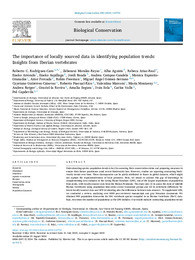Por favor, use este identificador para citar o enlazar este ítem:
https://hdl.handle.net/11000/33954
The importance of locally sourced data in identifying population trends: Insights from Iberian vertebrates
 Ver/Abrir: 44.pdf
Ver/Abrir: 44.pdf1,04 MB
Adobe PDF
Compartir:
Título :
The importance of locally sourced data in identifying population trends: Insights from Iberian vertebrates |
Autor :
Rodríguez-Caro, Roberto 
Morales-Reyes, Zebensui
et al. |
Editor :
Elsevier |
Departamento:
Departamentos de la UMH::Biología Aplicada |
Fecha de publicación:
2024-08-19 |
URI :
https://hdl.handle.net/11000/33954 |
Resumen :
Understanding species population trends is key for assessing their conservation status and proposing measures to
ensure their future persistence amid recent biodiversity loss. However, studies are reporting contrasting biodiversity trends over time. These discrepancies can be partly attributed to biases in global datasets, which might
not capture the representativeness of local processes. Here, we aimed to address this gap of knowledge by
complementing data included in the Living Planet Database (LPD), one of the largest repositories of population
time-series, with locally sourced data from the Iberian Peninsula. The study aim: (i) to assess the state of wildlife
Iberian vertebrates using population time-series across taxonomic groups and (ii) to determine differences between locally sourced data and LPD (evaluating also the differences between data sources). To supplement LPD,
we conducted a review, analysing over 6000 peer-reviewed manuscripts and grey literature documents. We
obtained 999 population time-series for 294 vertebrate species compiled in an Iberian Vertebrate (IbeV) database, two times the number of populations as the LPD includes. Our results indicate contrasting population trends across taxonomic groups, with freshwater amphibians and bony fishes showing steep declines. Moreover, the
LPD shows a positive trend and IbeV indicates no net change over time. Threatened species did not exhibit net
changes in population trends, while non-threatened species showed positive trends. We showed that local databases can provide distinct population trends compared to global databases. This approach highlights the need
to bridge the gap between global and local datasets, to support context-specific management and conservation
programmes.
|
Palabras clave/Materias:
Abundance
Amphibia
Aquatic ecosystems
Biomass
Conservation status |
Área de conocimiento :
CDU: Ciencias puras y naturales: Biología |
Tipo de documento :
info:eu-repo/semantics/article |
Derechos de acceso:
info:eu-repo/semantics/openAccess
Attribution-NonCommercial-NoDerivatives 4.0 Internacional |
DOI :
https://doi.org/10.1016/j.biocon.2024.110755 |
Publicado en:
Biological Conservation 298 (2024) 110755 |
Aparece en las colecciones:
Artículos Biología Aplicada
|
 La licencia se describe como: Atribución-NonComercial-NoDerivada 4.0 Internacional.
La licencia se describe como: Atribución-NonComercial-NoDerivada 4.0 Internacional.
 La licencia se describe como: Atribución-NonComercial-NoDerivada 4.0 Internacional.
La licencia se describe como: Atribución-NonComercial-NoDerivada 4.0 Internacional.
.png)
